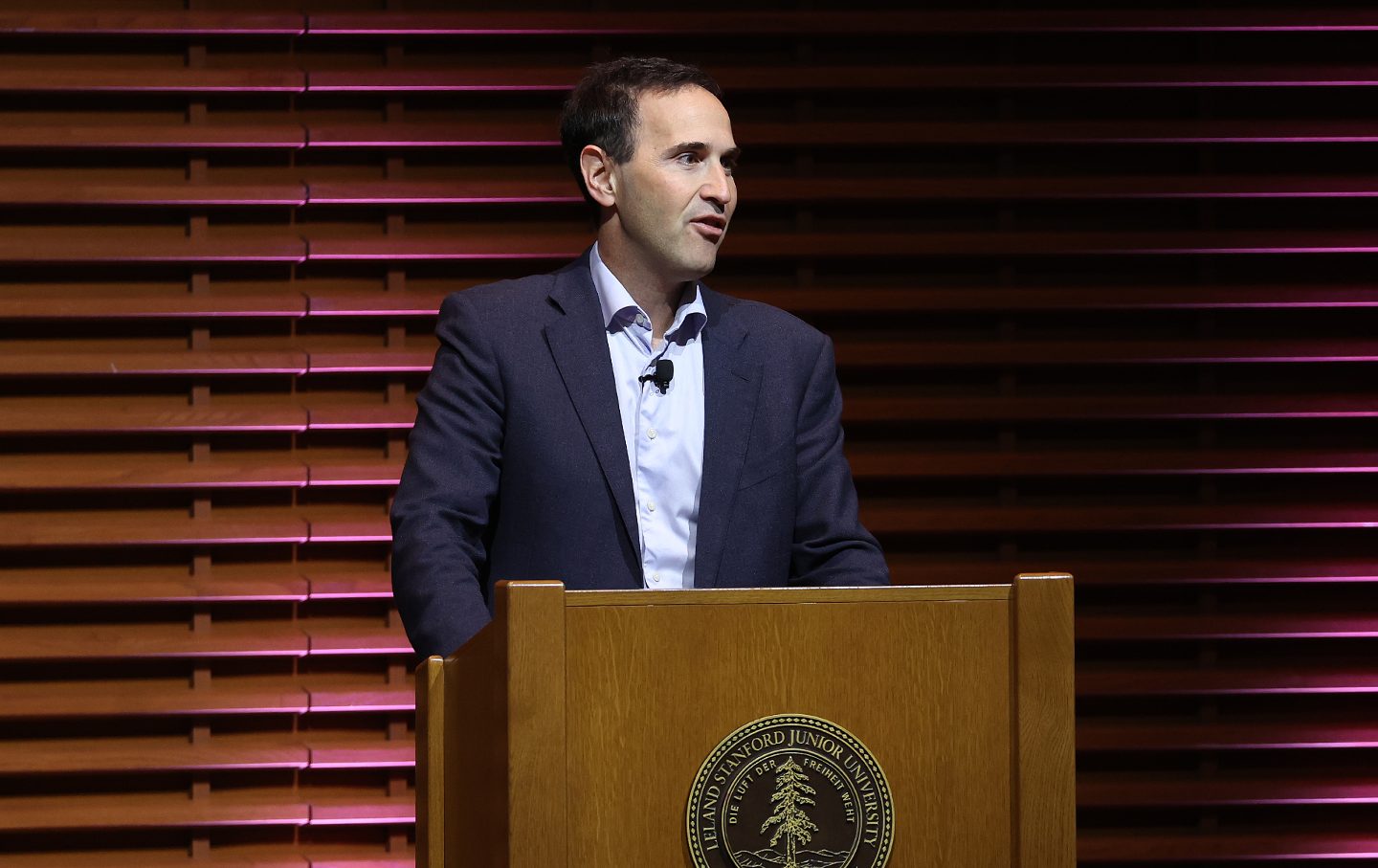Under a Second Trump Term, the DHS Will Be Even Harsher Than Before
Project 2025 lays out a vision of a new immigration enforcement agency that will be more effective than ever in deporting, detaining, and denying entry to immigrants.

This article is part of “Project 2025: The Plot Against America,” a Nation special issue devoted to unpacking the right’s vast and chilling program for a second Trump term.
The chapter on the Department of Homeland Security in Project 2025’s Mandate for Leadership, written in part by Ken Cuccinelli—who notoriously served as the acting director of US Citizenship and Immigration Services (USCIS) under President Trump—lays out a vision of an immigration enforcement agency that is even more draconian than its previous incarnation, one that will be purged of personnel who aren’t loyal to Trump and will be far less subject to oversight. Under the plan, the DHS would be dismantled, and immigration-related agencies from across the executive branch would be combined into “a stand-alone border and immigration agency” (except for the Transportation Security Administration, which would be privatized). Abolishing the DHS and starting from scratch would give the Trump administration an opportunity to oust anyone in the department who could pose a threat to the other plans laid out by Project 2025—such as the people who, during Trump’s first term, spoke out against policies like the asylum ban. This, the chapter notes, would require an act of Congress, as would many of the other recommendations delineated over the next 34 pages. But that could be less unlikely than it seems if Republicans take the Senate and hold on to the House this November.
Still, as Mandate lays out, there’s plenty that can be done without congressional approval. For better or worse, the Supreme Court has granted the executive branch broad discretion when it comes to immigration. This was, after all, how Trump accomplished most of his immigration policies, from the Muslim ban to family separation. During a second Trump term, executive authority would be used to deport as many people as possible: Project 2025 calls on Immigration and Customs Enforcement to expand “expedited removal,” a speedy deportation process for people apprehended within 100 miles of the border, to cover the entire country. ICE would lose much of its leeway to be able to deem cases “administratively closed,” as it sometimes does for people it determines aren’t a priority for removal. The agency would be required to detain most noncitizens with criminal records and almost entirely eliminate its “Alternatives to Detention” program, in which people in deportation proceedings are tracked in lieu of incarceration.
Project 2025
Legal immigration would also be curtailed: Several visa categories would be reduced or eliminated altogether, including so-called T and U visas, which are issued to victims of trafficking and other crimes who help police investigate the perpetrators of said crimes.
Asylum, too, would be gutted. The plan includes a new authority that would allow the DHS to expel migrants whenever there has been what it calls a “loss of operational control of the border.” Migrants who do manage to ask for asylum would likely be sent to other countries, because the proposal calls for reviving Trump-era border policies like “Remain in Mexico” and the “asylum cooperative agreements” with Central American nations.
People who are currently in the United States but lack permanent status—including people with temporary protected status and the hundreds of thousands of Afghans, Ukrainians, Venezuelans, Cubans, Nicaraguans, and Haitians recently admitted to the country under humanitarian parole—could have their status rescinded.
Under a second Trump administration, USCIS officers would be retrained to focus on “fraud detection rather than speed in processing.” Slow processing times would be used against migrants and prospective immigrants alike; the chapter suggests that, until the agency catches up on its backlog of cases, anyone whose application is rejected would be required to “leave the U.S. immediately,” eliminating any possibility of appealing the decision or reapplying from inside the country. USCIS would also increase the cost of all applications, implement fees for asylum petitions, and expand the “premium” processing track that would let people pay more to skip the line.
Congress hasn’t passed a major immigration law in decades, and the most recent attempt, which included plenty of restrictive policies that could have been plucked straight from the Heritage Foundation’s wish list, failed because Republicans refused to give President Biden a “victory” on immigration. Under Trump, the inverse would likely occur: Democrats who supported Biden’s attempted crackdown at the border would refuse to vote to codify policies backed by Trump. But Democratic opposition may be stymied if Republicans assume legislative control this November. With Congress on board, there is far more that Project 2025 envisions for Trump’s second term. The DHS chapter in Mandate calls on Congress to pass a bill that allocates additional funding for ICE agents to arrest immigrants living in the US; for the attorneys who argue for their deportations; and for more beds in immigrant detention facilities. To ensure that those beds are filled, the document also suggests that Congress change the law to state that noncitizens in deportation proceedings “shall” be detained. (Right now, the statute says immigrants “may” be detained, a stipulation few presidents have used with restraint.)
Project 2025 also proposes that Congress limit asylum eligibility for those hoping to find refuge in the US. It calls for raising the standard for what counts as a “credible fear,” the initial bar that migrants must clear as part of their asylum applications; codifying Trump-era barriers to asylum; and eliminating certain categories for asylum eligibility, which the Trump administration interpreted narrowly so as to exclude victims of domestic violence and people targeted by gangs.
As Mandate makes clear, Project 2025 also intends to make it easier to detain children in awful conditions. It calls on Congress to rescind the court settlement agreement that requires unaccompanied minors to be held in the “least restrictive setting” possible. Instead, large numbers of them could again be held in ICE detention. And those children would be deported more expeditiously too, since Project 2025 recommends that Congress repeal a section of the law that guarantees certain protections for migrant children.
Each of these policies would do significant damage on its own. Together, they’d affect tens of millions of people. As of late 2023, there were nearly 700,000 people with temporary protected status and 530,110 DACA recipients living in the US. Since he took office, Biden has admitted more than 1 million people from Ukraine, Afghanistan, Venezuela, Nicaragua, Cuba, and Haiti into the country, albeit temporarily. The policies would also be disastrous for the more than 12 million people with green cards, not to mention the estimated 11 million undocumented immigrants who have made lives here despite their lack of status.
Crucially, this would all happen with limited oversight. Expulsions during “mass migrations,” for example, would “not be subject to the requirements of the Administrative Procedure Act,” a law that prohibits capricious rulemaking. During Trump’s first term, many of his policies were scrapped not because of their discriminatory intent or horrific outcomes, but because they violated the APA. With four years to prepare, however—and a federal judiciary stacked in Trump’s favor—it looks like a second Trump term wouldn’t succumb to such pitfalls again.
Can we count on you?
In the coming election, the fate of our democracy and fundamental civil rights are on the ballot. The conservative architects of Project 2025 are scheming to institutionalize Donald Trump’s authoritarian vision across all levels of government if he should win.
We’ve already seen events that fill us with both dread and cautious optimism—throughout it all, The Nation has been a bulwark against misinformation and an advocate for bold, principled perspectives. Our dedicated writers have sat down with Kamala Harris and Bernie Sanders for interviews, unpacked the shallow right-wing populist appeals of J.D. Vance, and debated the pathway for a Democratic victory in November.
Stories like these and the one you just read are vital at this critical juncture in our country’s history. Now more than ever, we need clear-eyed and deeply reported independent journalism to make sense of the headlines and sort fact from fiction. Donate today and join our 160-year legacy of speaking truth to power and uplifting the voices of grassroots advocates.
Throughout 2024 and what is likely the defining election of our lifetimes, we need your support to continue publishing the insightful journalism you rely on.
Thank you,
The Editors of The Nation








